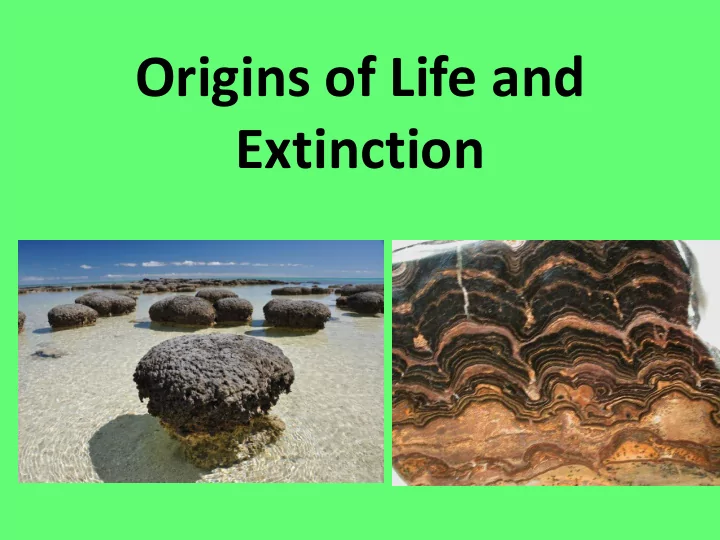

Origins of Life and Extinction
What is evolution?
What is evolution? • The change in the genetic makeup of a population over time • Evolution accounts for the diversity of life on Earth • Natural selection is the major driving mechanism of evolution
Evidence for Evolution • Charles Darwin used evidence to develop his theory of evolution by natural selection • Examples? • Today?
Evidence of Biological Evolution • Geographic – Distribution of living things • Geological – Fossils • Physical – Comparative Morphology/Embryology • Chemical – DNA nucleotide and protein sequences • Mathematical – Molecular Clocks or Radiometric Dating of Fossils
When did Earth form? Earliest life forms?
Origin of Life on Earth • Oparin’s Hypothesis • Primordial Soup Model (J.B.S. Haldane) • Urey-Miller Experiment • RNA World Hypothesis • Theory of Endosymbiosis
Oparin’s Hypothesis • Proposed that early life formed through a series of reactions that made simple compounds gradually into more complex organic molecules • Catalyzed by UV radiation and lightening • 3.9 to 3.5 billion years ago
Primordial Soup Model (Haldane) • Primitive Earth provided inorganic precursors (such as H 2 O, CO 2 , NH 3 ) from which organic molecules could be synthesized • Inorganic precursors served as monomers for the formation of complex organic molecules • Monomers produced polymers with the ability to replicate, store and transmit information
Primordial Soup Model
Urey-Miller Experiment • 1953 - Chemical experiment that showed it was possible to form complex organic molecules from inorganic molecules in the absence of life
RNA World Hypothesis • Proposes that RNA could have been the earliest genetic material, rather than DNA • Supported by the discovery of ribozymes • Ribozymes are capable of self-replication
Evolution of Early Life Organic Molecules Protocells Nonphotosynthetic Prokaryotes Photosynthetic Prokaryotes Unicellular Eukaryotes Multicellular Eukaryotes
Theory of Endosymbiosis • Describes how cells ingested other cells and became dependent on one another for survival ( symbiosis ), resulting in a permanent relationship • Prokaryotes to eukaryotes
Formation of Earth • Earth formed approximately 4.6 billion years ago • Environment was too hostile for life until approximately 3.9 bya • Fossil evidence for life dates to 3.7 bya – stromatolites (fossilized microbial mats of primarily cyanobacteria)
Fossil Evidence of Early Life
Geological Evidence of Atmospheric Oxygen • Free O 2 dissolved in surrounding water, eventually reacting with dissolved iron • Produces iron oxides which accumulate in sediments
Oxygen Revolution (2.5 to 2.7 bya)
Single-Celled Eukaryotes • Oldest fossils of eukaryotes are about 2.1 billion years old • Evidence for endosymbiosis ?
Multicellular Eukaryotes • Oldest known fossils are of small algae from 1.2 billion years ago • Animals during the Cambrian Explosion (535- 525 mya) – Cnidarians, Porifera, Mollusca • Colonization of land around 500 mya – fungi, plants, and animals • Earliest fossil tetrapods – 365 mya Choanoflagellates
Tetrapods • Tetrapods (four limbs) evolved from lobe- finned fish • “ Tiktaalik ” – transitional fossil of fish to first tetrapods (375 mya)
Continental Drift • What is continental drift? • How does continental drift contribute to evolution?
Continental Drift • Reshapes physical features of the planet • Alters habitats in which organisms live • Causes changes in climate • Promotes allopatric speciation by interrupting gene flow
Evidence for Continental Drift
Five Major Extinctions • Ecological stress?
Five Major Extinctions • Ordovician-Silurian – wiped out 85% sea life, blamed on an ice age • Late Devonian – wiped out 75% of ALL species, asteroids, climate change, new plants • Permian – “Great Dying”, 96% of ALL species, enormous volcanic eruptions ( flood basalt ), warmed Earth by 6°C, drop in oxygen levels
Five Major Extinctions • Triassic-Jurassic – wiped out 50% of ALL live, blamed on climate change, asteroids, plants were not as affected as animals • Cretaceous-Tertiary (K/T) – death of the dinosaurs, evidence of asteroid impact
Extinction and Evolution • Mass extinctions alter ecological communities • Fossil record indicates that within 5-10 million years, diversity of life recovers to previous years • Why?
Human Impact on Ecosystems and Species Extinction Rates • 6 th mass extinction • How are humans modifying the global environment?
Recommend
More recommend